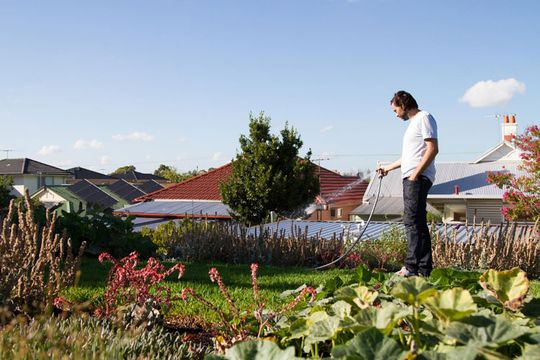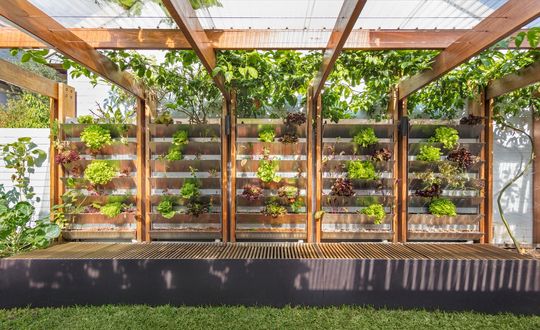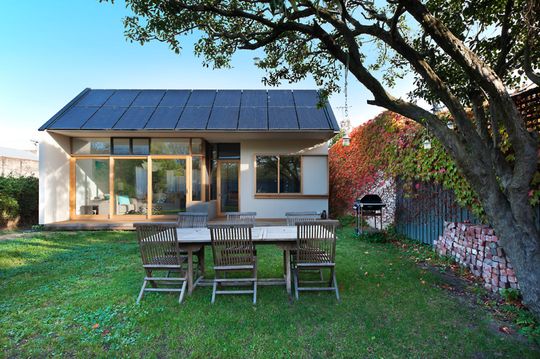As our cities grow and change, so does the way we think about living in them. The way we design our cities and homes is taking on a new, more sustainable approach, aimed at making our environments healthier, greener, and more liveable. This shift is bringing us closer to a future where nature and city life coexist harmoniously. Some of the exciting trends shaping this future include green roofs, vertical gardens, communal living spaces, and the use of renewable energy sources. These innovations are helping to transform our cities into more sustainable and enjoyable places to live.
Green Roofs: Nature on Top
This compact suburban home is topped by a beautiful green roof.
Imagine walking through the suburbs and looking up to see lush gardens on rooftops instead of just tin and tile. That’s the idea behind green roofs—roofs that are covered with plants, bringing a bit of nature to our suburbs. These living roofs do more than just look pretty; they help keep buildings cooler in the summer and warmer in the winter, which means less energy is needed for heating and cooling. Green roofs also soak up rainwater, helping to reduce the risk of flooding during heavy rains. Plus, they maximise green spaces in our cities, which are great for both people and wildlife.
Vertical Gardens: Green Walls That Breathe
A green wall with edible greens looks lush but is also the perfect urban farm for this household..
In homes where space is tight, vertical gardens are a brilliant solution. These gardens grow upwards on the sides of buildings, turning plain walls into vibrant green spaces. Not only do vertical gardens look amazing, but they also help clean the air by filtering out pollutants and absorbing carbon dioxide. Like green roofs, they can also help insulate buildings, making them more energy-efficient. And let’s face it, who wouldn’t prefer a view of cascading greenery over a blank wall of bricks or concrete?
Communal Living Spaces: Building Community in the City
This multi-generational home has a rooftop pool and deck overlooking the city..
Sustainable urban living isn’t just about the environment—it’s also about people and community. That’s where communal living spaces come in. These spaces are designed to bring people together, with shared gardens, kitchens, and recreational areas that encourage social interaction and a sense of belonging. By sharing resources, these communities reduce waste and consumption, making them a more sustainable choice. And on top of that, they offer a solution to the loneliness that can sometimes come with city life, helping people connect and build relationships in their neighbourhoods. Whether it’s the growth in multi-generational living, younger people pooling their resources to create a home together, or elderly people choosing to live with friends instead of a retirement home, communal living is a great option for more socially sustainable cities.
Renewable Energy: Powering Cities the Green Way
The roof of this addition is perfectly angled to maximise the solar panels' output..
As we move towards a more sustainable future, the way we power our cities is changing, too. Renewable energy sources like solar panels, wind turbines, and geothermal systems are becoming more common in urban areas. These clean energy options not only reduce our reliance on fossil fuels but also help cut down on the pollution that contributes to climate change. In some cities, entire neighbourhoods are being designed to run on renewable energy, showcasing just how powerful and practical these technologies can be. Combined with the rise in batteries, our homes will be increasingly powered by clean renewable energy.
A Greener Future for Us All
The future of urban living is looking greener and more sustainable, with designs that not only help the environment but also make our cities better places to live. Whether it’s the beauty of a rooftop garden, the practicality of a vertical wall of plants, or the warmth of a close-knit community sharing resources, these innovations are helping to create cities that are kinder to the planet and more enjoyable for everyone. As these ideas continue to grow and spread, we can look forward to living in cities where nature, technology, and community come together to build a brighter, more sustainable future.



